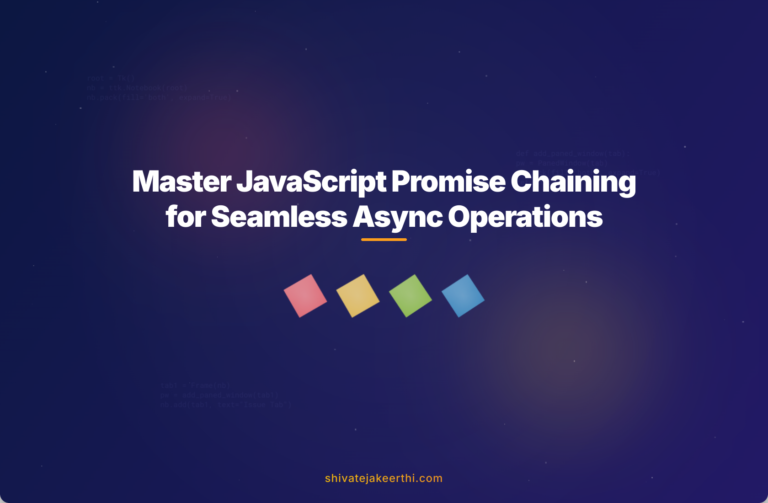Working with asynchronous JavaScript can feel tricky, especially when handling multiple steps like order processing and payments. A common method developers use to handle such scenarios is called promise chaining.
A Promise in JavaScript essentially represents the eventual completion or failure of an asynchronous operation. Think of ordering pizza online—you place an order (createOrder), pay for it (proceedToPayment), and receive confirmation. Promises allow your code to smoothly execute these steps one after another.
A handy way to organize multiple promises logically is through a concept known as Promise Chains, enabling clear, readable, and maintainable asynchronous code rather than complicated nested callbacks.
Setting Up a Promise Chain for Order Processing
To make this clear, let’s build a simple order-processing scenario step-by-step.
First, you have your cart array containing items the customer intends to purchase:
const cart = ["pizza", "pasta", "juice"];
Next, you create a function called createOrder(), which processes your cart and generates an orderId:
function createOrder(cart) {
return new Promise((resolve, reject) => {
if (!validateCart(cart)) {
reject("Cart is not valid.");
} else {
const orderId = "ORD" + Math.floor(Math.random() * 10000);
resolve(orderId);
}
});
}
function validateCart(cart) {
return cart && cart.length > 0;
}
In the code above, createOrder checks whether the provided cart is valid. If the cart passes validation, the promise resolves with an orderId.
Next comes the proceedToPayment() function, taking that orderId and processing payment:
function proceedToPayment(orderId) {
return new Promise((resolve, reject) => {
if (!orderId) {
reject("Order ID is missing.");
} else {
const payment = {
status: "Successful",
amount: 150,
orderId: orderId
};
resolve(payment);
}
});
}
Here we’ve ensured payment processing depends directly on a valid orderId. Upon resolving, this function provides a payment object.
Now, suppose you need to keep track of customer balance after payment. You might have a updateWalletBalance() function:
function updateWalletBalance(payment) {
return new Promise((resolve, reject) => {
const walletBalance = 500;
if (payment.status !== "Successful") {
reject("Payment failed, wallet not deducted.");
} else {
const updatedBalance = walletBalance - payment.amount;
resolve(updatedBalance);
}
});
}
Executing the Promise Chain
Now, let’s connect these steps using a promise chain clearly:
createOrder(cart)
.then(orderId => {
console.log("Order Created Successfully: ", orderId);
return proceedToPayment(orderId);
})
.then(payment => {
console.log("Payment done successfully for: ", payment.orderId);
return updateWalletBalance(payment);
})
.then(updatedBalance => {
console.log("Remaining Wallet Balance: $", updatedBalance);
})
.catch(err => {
console.error("Encountered error:", err);
});
With this promise chain, each step clearly depends on the previous—orderId and payment propagate naturally.
However, developers occasionally encounter issues such as ReferenceError: payment is not defined. Let’s see what’s happening there and how to resolve it efficiently.
Troubleshooting ReferenceError: payment is not defined
Seeing a ReferenceError here usually indicates a scope or return problem within your promise chain. Some common reasons include:
- Improper return statements: One of the promises might not be correctly returning the variable you’re expecting in the following step.
- Incorrect Parameter Passing: Forgetting to pass the parameter explicitly into the next chained promise.
- Scope Issues: Your variable may be defined inside another function or block, not accessible outside.
Let’s illustrate this clearly. Suppose your chain incorrectly leaves out returning the payment object correctly:
createOrder(cart)
.then(orderId => {
console.log("Order Created Successfully: ", orderId);
proceedToPayment(orderId); // payment is not returned, causing the next 'then' block to lose access.
})
.then(payment => { // "payment" becomes undefined here
console.log("Payment done: ", payment.orderId);
})
.catch(err => {
console.error(err);
});
In this broken example, proceedToPayment(orderId) was never returned explicitly. Hence, the next then() block loses track, suddenly finding payment undefined.
Resolving the error and accessing orderId and payment correctly
To fix this, ensure every promise returns explicitly to pass data down the chain like this:
createOrder(cart)
.then(orderId => {
console.log("Order Created Successfully: ", orderId);
return proceedToPayment(orderId); // explicitly returned to pass data forward
})
.then(payment => {
console.log("Payment Successfully Done for order: ", payment.orderId);
return updateWalletBalance(payment);
})
.then(updatedBalance => {
console.log("Wallet Updated. New Balance: $", updatedBalance);
})
.catch(err => {
console.error(err);
});
Notice by explicitly returning each function result, your variables (orderId, payment, balance) smoothly flow through your chain.
Another helpful practice is to maintain a shared scope if you need access to multiple variables at once. Here’s how you can preserve earlier results (like orderId and payment concurrently):
let savedOrderId;
createOrder(cart)
.then(orderId => {
savedOrderId = orderId; // store orderId in external scope
return proceedToPayment(orderId);
})
.then(payment => {
console.log("OrderId:", savedOrderId, "paid successfully.");
return updateWalletBalance(payment);
})
.then(updatedBalance => {
console.log("Remaining Wallet Balance: $", updatedBalance);
})
.catch(err => {
console.error(err);
});
Here, we cleverly stored orderId externally, so later in the chain, you can reference it alongside payment.
Testing thoroughly with tools like your browser’s JavaScript Console or premium editors like VS Code with debugging extensions is strongly recommended to verify variables flow correctly at every promise step.
Best Practices for Promises in JavaScript
To keep your asynchronous operations robust and maintainable, remember to:
- Always handle errors by chaining .catch() to capture rejected promises clearly.
- Explicitly return data at every step to ensure proper chaining.
- Avoid deeply nesting promises—utilize flat chaining instead.
For deeper understanding of promise error handling rules and usage, check out Promises in JavaScript Explained with Examples.
This way, you keep your code readable, maintainable, and bug-free, especially when working in larger teams.
Have you faced similar issues troubleshooting JavaScript promises? Share your experiences or questions below—let’s learn together and streamline our asynchronous JavaScript skills!



0 Comments